Enikő Bali
Geologist, Current residence: Reykjavík, Iceland (Home: XV. district (Rákospalota), Budapest, Hungary)
High pressure and temperature generation
There are variable methods to generate high pressure and temperature. Nowadays the only question for geologists is, which depth we would like to investigate.
I have to point out, that these techniques are used not only by geologists, but also (or mainly) by physicists and chemists, who produce new materials. They can study the physical behaviour of their materials in extreme conditions, thus they can decide if those are appropriate to use for building e.g. airplanes or spaceships etc.
Gas pressure vessels (up to 1 GPa and ~1400 °C)
At relatively low pressure conditions we use gas pressure vessels. Many types exist. The common thing in them is that the pressure transmitting medium (in which we place our sample) is some gas (H2O, CO2, Ar for example). This gas is sealed in a relatively large and long cylindrical vessel made of very hard alloys. In the lower pressure range (up to ~0.3 GPa), they are generally heated externally, the "high" pressure one is heated internally (Internally Heated Pressure Vessel, IHPV). Pressurization actually happen by the increase of temperature. Due to the increasing temperature the gas would expand, but instead of expansion pressure builds up in the tight vessels. The advantage of these techniques is that we can use relatively large samples (few cm wide and long) and the experiments can be run for relatively long time (weeks or even months for example). The disadvantage might be, that some of them might be very explosive, the vessels of IHPVs are placed in a separate room from the pressure and temperature control.
With these methods we can study for example magmatic processes in crustal conditions (what is going on in a magma chamber) or the formation of economically valuable ore deposits.
Piston cylinder (up to ~4 GPa and ~1800 K)
Piston cylinder apparatus is generally used between the pressure of 0.3 and 4 GPa, up to ~1800 °C. This pressure and temperature range allows us to study processes in the lower crust and uppermost mantle of the Earth. In this device the pressure transmitting medium is some solid material which deforms very evenly during the application of the pressure. Most people use salt (NaCl), alumina (Al2O3) or MgO as a pressure transmitting medium. Other materials exist, however some of them are toxic or difficult to machine to the exact dimensions.
I personally prefer the combination of MgO and salt, because I found that this had a low friction and very homogeneous pressure distribution in it. Pure NaCl would be the perfect one, but that cannot be used above ~900 °C, as salt melts around that temperature.
The figure below shows, how we assemble a pressure cell containing the capsule. As you see the sample size is quite small relative to the few cm3 sample size in the gas pressure apparatuses.

These are the parts of the pressure cell and thermocouple for a piston cylinder experiment. I use double capsule technique, because I would like to control the oxidation conditions in my experiment. For this I need a larger outer capsule with an oxygen-fugacity buffer and H2O. This should be separated from my sample, which is sealed into a smaller Pt-capsule. The reason of the separation is, that I would like to avoid reaction between the buffer and my "real sample".
This assembled pressure cell is put into a steel bomb, that has a Tungsten-carbide core. This core is very hard. The diameter of the hole in it is exactly the same as the diameter of the pressure cell (generally 3/4 or 1/2 inches). There is of course a piston that belongs to these bombs. This piston is also made of tungsten carbide and fits to the cylindrical hole perfectly.
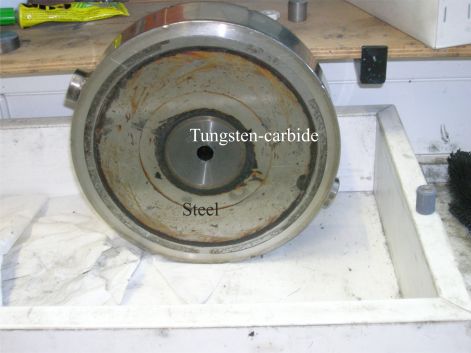
A "piston cylinder bomb".
The figure below shows a schematic cross section of a piston cylinder press. The pressure is generated on our sample by moving the piston upwards in the hole. This movement is done by the help of a hydraulic press. In order to keep the whole system in equilibrium and prevent deformation we should apply pressure also from the top (end load). Some of the old presses do not have this function, they are the "non-end loaded" machines. They generally cannot be used to very high pressures. Heating happens through the copper electrodes.

Cross section of a piston cylinder apparatus. Pressure is generated on the sample by a hydraulic press, which moves a Tungsten-carbide piston upwards in a hole where the sample is situated (sample-black-is surrounded by a pressure transmitting medium). The pressure cell is supported by Tungsten-carbide all around and the pressure can be regarded homogeneous on the sample. This device is used between 0.5 and 3.5 GPa up to 1800 K temperature regularly. Higher pressures (up to 6 GPa) and temperatures (up to 2000 K) can be generated in some special presses, though these experiments cannot be regarded as standard ones.
And this is how it looks like in reality in our lab in Göttingen.
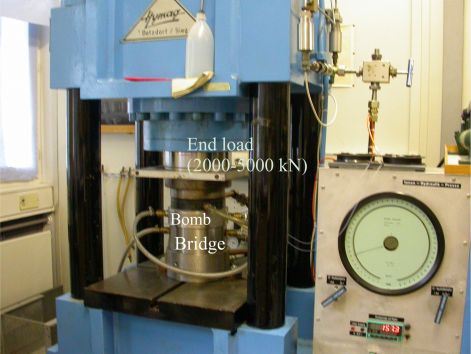
As we generate very high temperatures the system should be water cooled. Those are these hoses around. You can also see in the bottom right corner that the oil pressure on the piston is 157.3 bars, which in reality corresponds to 1.5 GPa pressure on my sample.
Multi anvil apparatus (up to ~25 GPa and ~2500 K)
Multi anvil apparatus is used between ~3.5 and 25 GPa and up to ~2500 K. With this device we can study processes in the whole range of the upper mantle, down to the transition zone (see the structure of the Earth). In this case the pressure medium is a Cr2O3-doped MgO-octahedron.
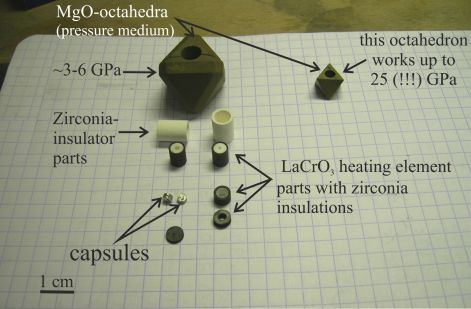
Here you can see the parts of the pressure cell and the capsules. The outer diameter of the sample, here is 3 mm. For experiments at 25 GPa, this sample size reduces below 1 mm. Putting together needs a certain patience  .
.
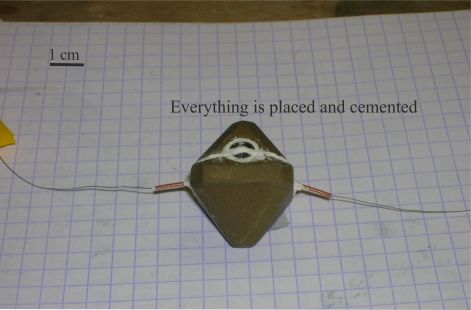
It looks like this, when the octahedron is fixed. The two wires at the sides are the thermocouples.
The pressure on our sample is generated by two sets of anvils. The "inner" anvil set is composed of 8 Tungsten-carbide cubes of which corners are truncated in a way that it can host the octahedron. This 3.5-25 GPa pressure range is very large, of course we have to use different sized octahedra (smaller for higher pressures) and the the cube truncations should also be variable to cover the whole pressure range.
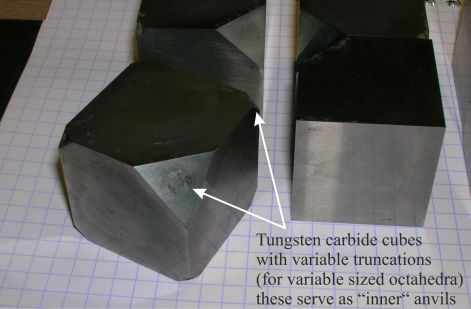
Tungsten carbide cubes with different truncation lengths.
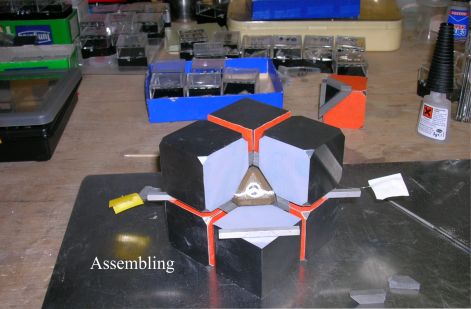
Assembling of the "inner" anvils. Anvils should be insulated from eachother, otherwise we cannot heat the experiment.
The assembled cubes are put among a second set of "outer" anvils which are formed to host the cube. These "outer" anvils are than closed and pressurized by a hydraulic press.
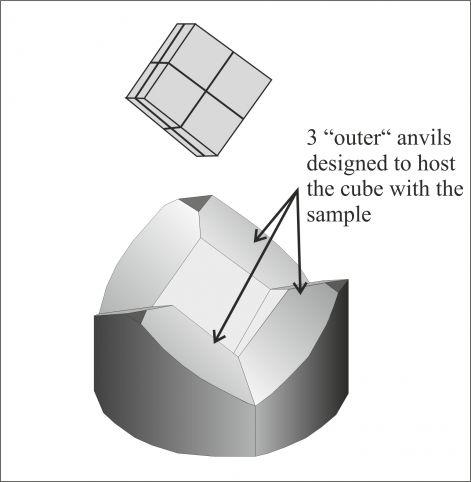
Schematic drawing of the outer anvils opened.

This is how it looks in reality.
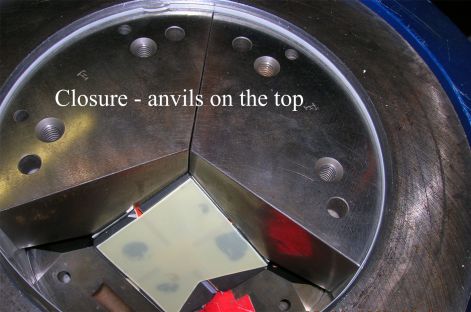

Diamond Anvil Cell (up to ~150 GPa and ~4000 K)
With this pressure cell we can reach very high pressures and temperatures getting some information on the behaviour of minerals in lower mantle and D'' conditions. In contrast with the previous devices, diamond anvil cells do not need a whole room. They are very small thus the sample we can study with them is very small either. Generally the studied sample is a small single crystal.
This pressure cell is composed of 2 high quality diamonds; a gasket between them with a hole; and support rings with which we generate pressure. The sample goes to the small hole of the gasket together with the gas pressure medium and a ruby crystal. The fluorescence of the ruby crystal gives us information on the pressure inside the cell. These cells can be heated externally, like that it is possible to reach ~1200 K. Real high temperatures are generated by a laser heating on the sample. Pressure is generated simply by screwing the support rings together. The two hard and very spiky diamond peaks generate the pressure.
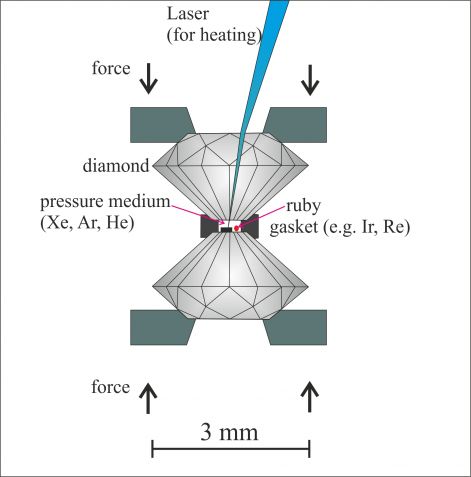
A schematic diagram of a laser heated diamond anvil cell. As you can see the sample size might be well below 1 mm, in diameter.
Besides reaching very high pressures and temperatures the advantage of this device is that the sample can be directly observed during the experiment as diamonds are transparent. You can study the sample relatively easily directly by X-rays for example. Another advantage is that it is relatively inexpensive (only relatively  , I will never keep one at home). The disadvantage is the very small sample size and the extreme temperature gradient in the sample chamber. We do meet the problem of inhomogeneous temperatures in the pressure cells of other devices, but in case of laser heated diamond anvil cell it might really be few hundred °C.
, I will never keep one at home). The disadvantage is the very small sample size and the extreme temperature gradient in the sample chamber. We do meet the problem of inhomogeneous temperatures in the pressure cells of other devices, but in case of laser heated diamond anvil cell it might really be few hundred °C.

This schematic figure shows how deep we can reach with commonly used experimental devices.
Mai: 15
Tegnapi: 64
Heti: 409
Havi: 624
Össz.: 189 602
Enikő Bali - © 2008 - 2026 - enikobali.hupont.hu
